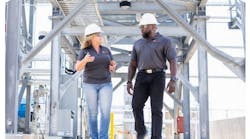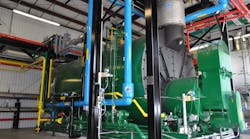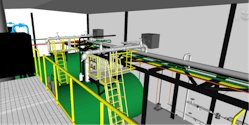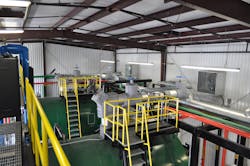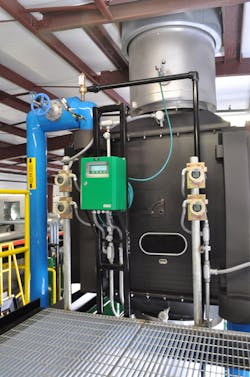Several times a day — during lunch breaks, shift changes, process transitions — the coal-fired steam plant serving the Wilson, N.C., tobacco-processing facility of independent leaf-tobacco merchant Alliance One International Inc. would drop below 30,000 lb. per hour of facility demand and, unable to modulate lower, be forced to vent excess steam into the atmosphere, resulting in excessive energy use.
In 2013, RMF Engineering teamed with Concord, N.C.-based AC Technical Services to design and build a new natural-gas-fired steam plant for Alliance One.
The Coal-Fired Power Plant
The 40-plus-year-old coal-fired power plant faced the normal challenges associated with coal steam production: slow startup, limited boiler modulation, and high maintenance costs. Additionally, the plant never exceeded a 50,000-lb.-per-hour load, yet was served by two towering 75,000-lb.-per-hour boilers.
Planning
Prior to design, a thorough planning process took place to ensure the new plant would meet the short- and long-term goals of Alliance One. The team began by evaluating the site and systems, obtaining feedback from facility engineers, and gaining a thorough understanding of the production process. The goal for the project was to engineer a steam plant that was efficient, reliable, and appropriately sized.
Various solutions, including retrofitting the existing boiler plant, constructing a new boiler plant adjacent to the existing plant, and constructing a new electricity-and-steam cogeneration plant, were developed and analyzed. Financial and energy models compared the first and maintenance costs and the energy use of new equipment with those of the current operation.
Net-present-value analysis of three options indicated a new plant utilizing three gas-fired, 900-BHP fire-tube boilers with fuel-oil backup and feedwater economizers would provide excellent flexibility, N+1 reliability, and a substantial reduction in energy, operation, and maintenance costs. Simple-payback analysis indicated the plant would pay for itself in a little less than seven years, given the anticipated energy savings and reduced maintenance and operating costs.
The selection of 900-BHP units was determined to allow comfortable turndown for handling minimum loads, provide full capacity with one unit down, and leave room for future facility expansion.
The initial equipment selections were heavily influenced by first cost and energy use. Fire-tube boilers provided quick startup, and with the addition of continuous-blowdown heat exchangers and feedwater economizers, the theoretical fuel-to-steam efficiency of the new steam plant approached 86 percent, a significant upgrade over the approximately 78-percent efficiency of the coal-fired plant.
Feedwater economizers were utilized to extract waste heat from the flue stacks to pre-heat water fed to the boilers, and the continuous-blowdown feed was run through a heat exchanger to preheat makeup water. The plant was controlled using modern programmable logic controllers, control panels on each boiler, and a central master controller between each boiler’s control system and other boiler-room equipment — all with interactive human-machine interfaces.
Also included in the design of the controls was full metering on all fuel, steam, condensate, and makeup water. The comprehensive approach to the boiler-plant controls and metering allowed the owner to operate, log, tune, and troubleshoot the boiler plant with ease.
Design
The design process began with thorough interviews of plant operators, engineers, technicians, and managers.
The facility is where initial grading and processing of tobacco takes place. From spring and early summer, when minimal processing activity takes place, to late fall, when all processing lines are in operation, it experiences varying levels of production. During the off-peak season, the coal-fired plant required operators to come in a day before production was to begin to start up the boilers and steam systems. The new natural-gas boilers, on the other hand, could be started a few hours before production, eliminating a full workday for boiler operators.
Aside from reducing startup-related labor costs, the natural-gas boilers allow the plant to support the minimum load without cycling equipment on and off and support peak loads with room for expansion. Auxiliary-equipment sizing took into account the variety of conditions the plant experiences.
For example, depending on the stage of processing, the plant can see anywhere from 80 percent to nearly 0 percent condensate returned. Multiple deaerator steam control valves were sized and arranged to account for the breadth of makeup water conditions.
Challenges
With the coal-fired plant, piping, valves, and equipment were not easily accessible, and lighting was far from ideal. The design team modeled the new facility using 3D-modeling software. Once the preliminary layout was completed, the team took the model to Wilson for a virtual walk-through of the plant.
The facility engineers, project manager, boiler-plant operators, and designers reviewed valves, sensors, inspection ports, and anything else requiring operator interaction from all angles. Piping was adjusted, valves were relocated, and the client’s personal preferences were taken into consideration early in the design period.
Once the piping and valving were finalized, the design team used piping design and analysis software to conduct a thermal-stress analysis of the steam, condensate, feedwater, and safety relief piping systems. This allowed the design team to better locate piping anchors and guides, establish equipment-flange loading was safely within the manufacturer’s tolerance for forces and movement, and verify the system was code-compliant.
The result is a plant in which every valve, access door, and instrumentation device is accessible from the ground or a permanent platform. Design details, such as removable insulation jackets on steam isolation valves and meters and color-coded insulation covers, greatly improve operation and maintenance.
The use of 3D modeling additionally aided installation of the system, as 3D isometrics of complex areas and a general plant overview allowed design intent to be communicated on contract documents. Furthermore, during construction, the design team provided to the contractor a 3D model viewable using a free 3D viewer. The result was a plant constructed on time, with minimal requests for information and design changes.
Success
Alliance One went from an inefficient coal-fired steam plant to an energy-efficient and environmentally friendly natural-gas-fired one. Thanks to integrated design and careful selection of equipment, accessories, and components, the plant has been operating reliably and efficiently for over two years. The benefits of converting from coal to natural gas are measurable.
From a site standpoint, the owner is able to recover the land previously occupied by the coal plant. On the production front, cost per hundred pounds processed is down because of the efficiency and low operating cost of the steam plant. Increased plant reliability, meanwhile, has allowed operators to focus on other aspects of facility operations. Furthermore, plant carbon-dioxide and nitrogen-oxide emissions have been reduced.
With increased energy efficiency, reliability, and environmental benefits, the conversion from coal to natural gas truly has been a win for Alliance One.






